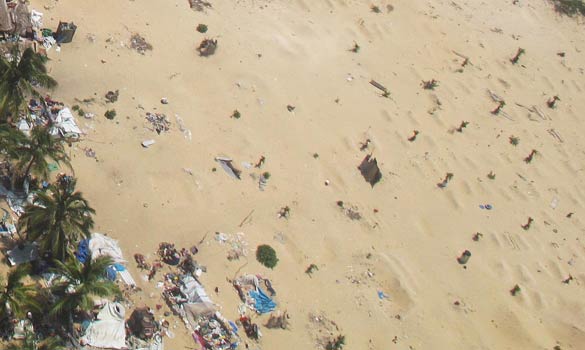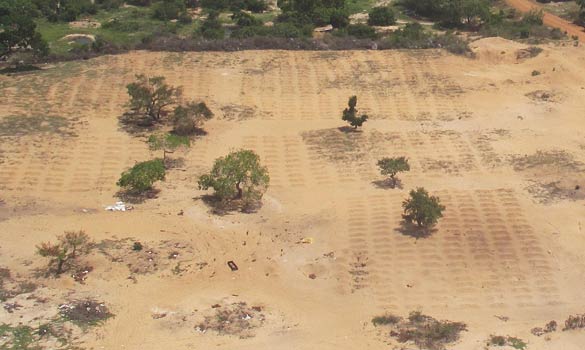Ilankai Tamil Sangam13th Year on the Web Association of Tamils of Sri Lanka in the USA |
|||
 Home Home Archive by Date Archive by Date Archive by Category Archive by Category About the Sangam About the Sangam Engage Congress Engage Congress Multimedia Multimedia White Papers White Papers Links Links Search This Site Search This Site |
Times Photographs Expose Sri Lanka’s Lie on Civilian Deaths at Beachby Catherine Philp and Michael Evans, Times Online, UK, May 29, 2009
On Wednesday evening the Sri Lankan delegation at the United Nations Human Rights Council in Geneva was celebrating after its victory in fending off an investigation into alleged war crimes committed by its army. Sri Lanka’s Government has consistently denied killing civilians in the battle to wipe out the Tamil Tigers and blamed the rebels for any deaths. It hailed the vote by the council as a vindication of its action. An investigation by The Times into Sri Lanka’s civilian casualties, however — which was conducted in a week-long visit to Sri Lanka — has found evidence of a civilian death toll of 20,000, almost three times that cited previously. The majority perished under government guns. Confidential UN documents, the testimony of witnesses who lived through the bombardment and expert analysis of photographs that were taken on a helicopter flight over the no-fire zone attest to the deaths of thousands of Tamils, killed while acting as unwilling human shields by the Tamil Tigers, who claimed to be their liberators. Related LinksMultimediaIntended as a haven for civilians, the no-fire zone became a killing field instead for the thousands trapped between the rebels and the army. Summaries of UN documents leaked this month confirmed almost 7,000 dead in the first four months of the year. More than 13,000 civilians were killed until May 19, the day after the death of Velupillai Prabakharan, the leader of the Tigers, was announced. That figure is based on the growth in the intensity of shelling in May, resulting in an average of 1,000 civilian deaths every day. “These figures are not even complete yet,” the UN source said. “It’s going to end up way more.”
The Times has acquired a full set of the documents showing the previously unreleased breakdown of the weaponry that caused each death and revealing the scale of carnage from shelling which defence experts said could have come only from the army’s side. The UN figures until the end of April, which are based on death records, show that 2 per cent of deaths in January, the beginning of the final offensive, were caused by gunfire and more than 80 per cent by shelling. Many of those shot were killed by the Tamil Tigers when they opened fire on civilians to prevent them from escaping after being held as hostages in the no-fire zone. In February, 15 per cent were killed by gunfire as more civilians attempted to escape and 64 per cent were killed by shelling. The numbers killed by shelling doubled from March to April, with an average of 129 every day. Three independent defence analysts who examined photographs of army and rebel firing positions taken over the no-fire zone confirmed that the range of the rebel weaponry and the narrowness of the zone make it unlikely that rebel munitions caused significant civilian casualties. One told The Times that rebel mortars would have hit civilians only if their weapons had malfunctioned. “It’s possible that some of the mortars might have misfired causing some of the damage but this sort of occurrence is rare,” Charles Heyman, a former army officer and editor of the magazine Armed Forces of the UK, said. “It looks more likely that the firing position has been located by the Sri Lankan Army and it has then been targeted with air-burst and groundimpact mortars.”
Mortars are an indiscriminate weapon employed usually to take out groups of fighters on an open battlefield. Use of imprecise weapons of this kind in densely populated civilian areas is a war crime under Common Article 3 of the 1949 Geneva Convention — to which Sri Lanka is a signatory. Mortars — the Sri Lankan Army has 81mm, 82mm and 120mm rockets — can detonate on the ground where the impact would be absorbed partially, or between 100ft and 200ft above the ground, causing a mass of shell fragments. Air-burst and ground-impact mortars can cause wide destruction and reduce trees to burnt stumps — one of the sights seen frequently in The Times photographs. According to a former Sri Lankan army officer, the Tamil Tigers did not possess air-burst mortars. Their heavy weaponry had a range of 7 to 27km, meaning that most of their fire would have fallen outside the zone. UN projections based on the last five days of April predicted an average May death rate of 341 every day, but the month was to prove bloodier. Until the end of April, the death toll was collated from the number of bodies arriving at improvised medical centres or reports from doctors, priests and humanitarian workers inside the no-fire zone. Bodies taken to the medical centres or casualties who died undergoing treatment accounted for not more than 19 per cent of the total death toll. In one day, when the names of 198 dead were collected, only 39 bodies were taken to the medical centre. In the four days leading up to and including May 13, an average of 220 bodies were taken to medical points. On the worst day, the toll reached 480. Workers were unable to collect reports of other deaths because of the intensity of the bombing. Based on the previous ratios, a conservative estimate still comes out at more than 1,000 civilian deaths each day, one UN source noted. Counting of any kind was abandoned on May 13 when the bombardment reached such an intensity that most humanitarian staff had left and others were unable to leave their bunkers. Still unaccounted for are 3,000 wounded civilians who were left in the last medical post in the no-fire zone when the remaining medical staff fled. One humanitarian worker told The Times that makeshift hospitals had been repeated targets for the Government, which claimed that rebels were hiding in them. In some cases, he said, the medical posts were bombed within hours of doctors telephoning their co-ordinates to the International Committee of the Red Cross so that the military could avoid bombing them. UN sources accused the Government of waging “a war without witnesses”. “They didn’t want anyone left to say what had happened,” one said. Three Sri Lankan doctors who reported on civilian casualties within the no-fire zone are being held on charges of spreading false information. UN sources said that their workers were trying to discover the fates of thousands more who are missing. The task is complicated by the internment of Tamil civilians in military-run camps beyond the reach of humanitarian organisations. No independent observers have been given access to the war zone. The Times was able to photograph the no-fire zone while travelling with Ban Ki Moon, the UN Secretary-General. It is the only British publication to do so. The Times has made two official visits to Manik Farm camp in the last week, during which those who had fled the no-fire zone testified to their grim experiences there. With the backing of its power ally China, there appears little prospect that the Government will be investigated for alleged war crimes. All of the Tiger leadership have been killed, leaving only middle-ranking cadre to face justice. Common Article Three of the Geneva Convention prohibits the use of indiscriminate fire against civilian areas, even when a military force is using them as a shield, as the Tigers can be seen to have been doing in the photographs. The Government’s restriction of humanitarian law may constitute a war crime. Sri Lanka’s 2006 Geneva Conventions Act purports to enshrine the conventions in its law but, according to the Rule of Law in Armed Conflict Project at the Geneva Academy of Humanitarian Law and Human Rights, it specifically excluded internal conflicts. Legal experts said, however, that the loophole, designed to exclude the war with the Tamil Tigers, did not exclude Sri Lankan commanders from international prosecution. The Government’s words January 31 President Rajapaksa I urge the LTTE, within the next 48 hours, to allow free movement of civilians to ensure their safety and security. For all those civilians, I assure a safe passage to a secure environment. April 27 President’s office Our security forces have been instructed to end their use of heavy calibre guns, combat aircraft and aerial weapons, which could cause civilian casualties. April 28 Brigadier Udaya Nanayakkara We have not used any shelling or mortaring, only small arms. We know how we are fighting. May 1 Palitha Kohona, Foreign Secretary As long as the retaliation is proportionate it is perfectly legitimate and what we did exactly was locate these guns and retaliate against those guns. But I would challenge anybody to say that these shell holes were created once the civilians moved into the area May 11 Gotabaya Rajapaksa, Defence Secretary Nothing could be as ridiculous as a claim of more than 2,000 civilians being killed in a single barrage. May 17 Mahinda Samarasinghe, Human Rights Minister Soldiers saved all Tamil civilians trapped inside the war zone without shedding a drop of blood May 21 The government minister, former Tiger leader, Vinayagamoorthy Muralitharan There are casualties and we have to appreciate the casualties because without them you can’t rescue the people. More pictures here. |
||
|
|||


